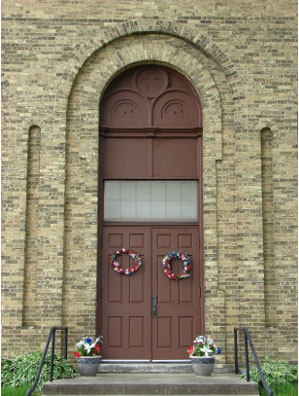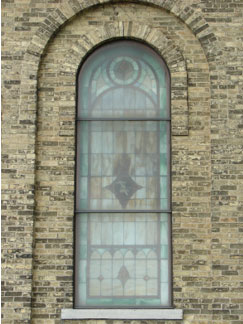52. Salem Lutheran, 1863
6840 North 107th Street (north of Mill Road)
This modest country church is located in the northwestern corner of the city, in what was formerly the small settlement of West Granville in rural Granville Township. At the time of its construction, the church was almost seven miles beyond the city limits of Milwaukee.
A small group of Granville Township residents, primarily German-speaking farmers who had moved to Wisconsin from Pennsylvania, founded Salem Evangelical and Reformed Church in 1847. Their first church, built of logs in 1849, was located adjacent to the cemetery across the street from where the brick church of 1863 now stands. Although there were doctrinal differences among the founding members, the arrival of a new pastor in 1849 led to the adoption of a strictly Lutheran doctrine for the church, which was known from that time on as Salem Evangelical Lutheran.
In 1860, a portion of the congregation withdrew and formed West Granville Presbyterian Church. The new Presbyterian congregation built a small brick church in 1861, which still stands just a few hundred feet to the north of where the log church had been. Two years later, Salem Lutheran congregation built its own brick church directly across the street from the cemetery.
The church is not strongly associated with any architectural style. The arched front doorway and façade windows are set within slightly recessed areas of brick, and the windows originally had clear glass in small rectangular panes. Both of these features are seen on earlier American churches in the classical tradition. However, Salem Lutheran has no other distinctly classical features. There are also a few features of the Italianate style, which was popular at the time but much more common for residential and commercial buildings than churches. Italianate features include the decorative eave brackets and the projecting brick forming hoods over the arched windows along the side walls. As a small vernacular building constructed not long after Granville Township’s initial settlement, the church was likely planned and erected by a builder without the services of an architect, and without a self-conscious attempt to design in a particular architectural style.
A steeple originally rose from the square tower, but was removed in 1922 or possibly earlier. The tower itself was reconstructed as part of a substantial renovation project in 1922. The present windows of opalescent glass were also installed as part of this renovation. Later alterations include the construction of a basement in 1946 and a classroom addition at the rear of the church in 1949.
A series of annexations by the City of Milwaukee gradually brought the boundary of Milwaukee closer to the church, until the city annexed the western portion of Granville Township in 1956, bringing the church property within the city limits. The congregation built a new and much larger church on the property in 1977, and since 1985 the old church has been used as a museum, operated by the Wisconsin Evangelical Lutheran Synod (WELS). The museum focuses on the history of the synod, which held its first convention in the original log church in May of 1850. Salem Lutheran is therefore considered the birthplace of the Wisconsin Synod, as noted on a historical marker placed on the church property by the Wisconsin Historical Society.
Sources:
1847-1947 Centennial, Salem Evangelical Lutheran Church. Salem Evangelical Lutheran Church, 1947.
Bird, Miriam Y. A History of Granville Township, 1996.
Historic Designation Study Report: Salem Evangelical Lutheran Church. City of Milwaukee, 1982.
Jeske, Mark A. “Salem Lutheran Church and the town of Granville, 1830-1870.” WELS Historical Institute Journal, Fall 1985.
Johnston, James M. “Church Has Country Look,” Milwaukee Sentinel, July 1, 1978, part 1, page 9, column 4.
Mary Ellen Young Papers, Milwaukee County Historical Society Archive.
“Salem Evangelical Lutheran Church.” 125th Anniversary brochure, 1972.



